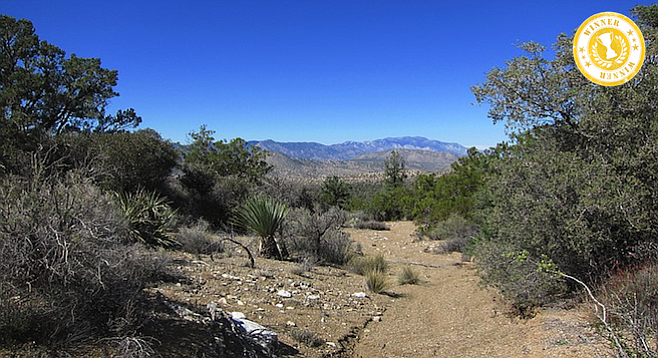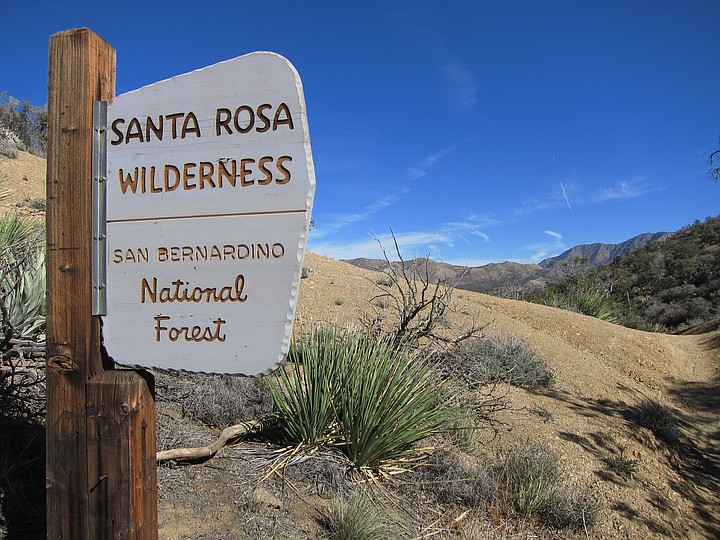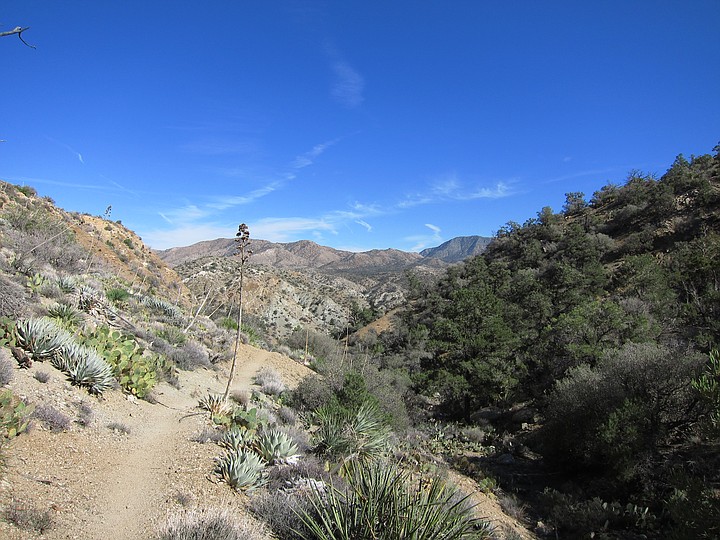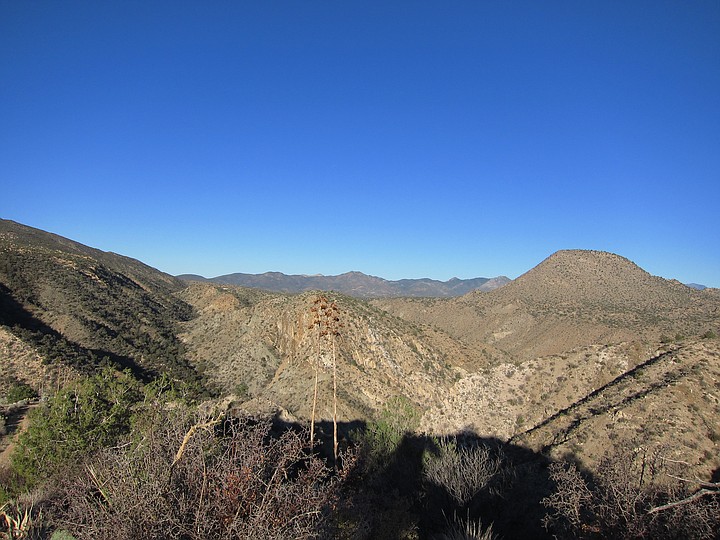 Facebook
Facebook
 X
X
 Instagram
Instagram
 TikTok
TikTok
 Youtube
Youtube

My boots grate loudly over the gravel as I shuffle onto my crinkly tarp. After manhandling spare clothing into a fussy Sea to Summit stuff sack, I rustle into my Kelty down sleeping bag. With a soft thud, I collapse onto a makeshift down-jacket pillow and stare soundlessly at the clear mantle of stars overhead.

The silence is striking.
Suddenly, my sense of hearing is triggered by the unmistakable caterwauling of one, and then two, nearby mountain lions. The world around the Santa Rosa Wilderness seems as remote as you can get in Southern California. Alert and carefully arranging my headlamp and three-inch Gerber knife, I quietly fall asleep.
This is my first trip into the Santa Rosa Wilderness, and I quickly discover that the area is the perfect "weekend warrior" getaway for rugged backcountry hiking.
Arriving at the CA-74 trailhead two and a half hours after leaving my Chula Vista worksite on Friday afternoon, I push two miles along the solitary Cactus Spring Trail before nightfall prompts me to find a flattish campsite. Waking up early, I devour a Jetboil full of Quaker Oats and continue on the well-maintained path.

The trail quickly descends into Horsethief Creek’s precipitous canyon, where the creek gurgles cheerfully and leafy Fremont cottonwoods provide a respite from the morning’s merciless sun. February’s record-setting heatwave is unforgiving on the relatively shadeless trail.
Spreading across the Santa Rosa Mountains just north of Anza-Borrego Desert State Park, Santa Rosa Wilderness is an isolated patch of 58,878 acres within Santa Rosa and San Jacinto Mountains National Monument.
The wilderness is characterized by broken, water-corroded ridgelines that rise dramatically from sandy runoff drainages. To the east, arid hillsides are strewn with ocotillo, desert agave, and teddybear and silver chollas. The majority of the wilderness, however, receives sufficient rainfall to support a beautiful brushwood layer of ribbonwood, palo verde and manzanita, while California juniper and singleleaf pinyon pine mishmash across the landscape.

Passing wooden signpost markers at regular intervals, the next five miles traverse level hardpack gravel, stretches of loose-rock descents, and a near-vertical uphill climb of several hundred feet before finally winding through a quiet, sandy streambed to Little Pinyon Flat at 4,000 feet above sea level.
My destination is indeterminate, but I find a knob-like hill that I promptly climb to enjoy a mid-morning siesta. The incredible 360° vista from the summit encompasses the entire arroyo-strewn wilderness. Toro Peak dominates the view from 8,716 feet, while Martinez Mountain rises to 6,425 feet in the east.
I share the shade of a juniper with several Costa’s hummingbirds, a magnificent western tiger swallowtail butterfly, and a curious rock lizard.
The seven-mile return trip is brisk, and I pass two couples and a solo hiker who are each heading to Cactus Spring, the usual terminus for a hearty day hike in the wilderness. Other potential destinations include Horsethief Creek, Agua Alta Spring, and innumerable cross-country hilltops or mountain summits.
The wilderness is accessible from two points off CA-86 in Coachella Valley or via a single entry off CA-74. A visitor’s center 15 minutes east of the CA-74 trailhead offers useful maps of the area and the obligatory wilderness patch for your backpack. Although running water may be found throughout the year, bring plenty to cover all of your needs, especially during the sweltering summer months.
Plentiful scat and tracks confirms the presence of the United States’ largest population of Peninsular bighorn sheep, but I am not lucky enough to spot any this time.
Never say never; I’m already planning a return trip!


My boots grate loudly over the gravel as I shuffle onto my crinkly tarp. After manhandling spare clothing into a fussy Sea to Summit stuff sack, I rustle into my Kelty down sleeping bag. With a soft thud, I collapse onto a makeshift down-jacket pillow and stare soundlessly at the clear mantle of stars overhead.

The silence is striking.
Suddenly, my sense of hearing is triggered by the unmistakable caterwauling of one, and then two, nearby mountain lions. The world around the Santa Rosa Wilderness seems as remote as you can get in Southern California. Alert and carefully arranging my headlamp and three-inch Gerber knife, I quietly fall asleep.
This is my first trip into the Santa Rosa Wilderness, and I quickly discover that the area is the perfect "weekend warrior" getaway for rugged backcountry hiking.
Arriving at the CA-74 trailhead two and a half hours after leaving my Chula Vista worksite on Friday afternoon, I push two miles along the solitary Cactus Spring Trail before nightfall prompts me to find a flattish campsite. Waking up early, I devour a Jetboil full of Quaker Oats and continue on the well-maintained path.

The trail quickly descends into Horsethief Creek’s precipitous canyon, where the creek gurgles cheerfully and leafy Fremont cottonwoods provide a respite from the morning’s merciless sun. February’s record-setting heatwave is unforgiving on the relatively shadeless trail.
Spreading across the Santa Rosa Mountains just north of Anza-Borrego Desert State Park, Santa Rosa Wilderness is an isolated patch of 58,878 acres within Santa Rosa and San Jacinto Mountains National Monument.
The wilderness is characterized by broken, water-corroded ridgelines that rise dramatically from sandy runoff drainages. To the east, arid hillsides are strewn with ocotillo, desert agave, and teddybear and silver chollas. The majority of the wilderness, however, receives sufficient rainfall to support a beautiful brushwood layer of ribbonwood, palo verde and manzanita, while California juniper and singleleaf pinyon pine mishmash across the landscape.

Passing wooden signpost markers at regular intervals, the next five miles traverse level hardpack gravel, stretches of loose-rock descents, and a near-vertical uphill climb of several hundred feet before finally winding through a quiet, sandy streambed to Little Pinyon Flat at 4,000 feet above sea level.
My destination is indeterminate, but I find a knob-like hill that I promptly climb to enjoy a mid-morning siesta. The incredible 360° vista from the summit encompasses the entire arroyo-strewn wilderness. Toro Peak dominates the view from 8,716 feet, while Martinez Mountain rises to 6,425 feet in the east.
I share the shade of a juniper with several Costa’s hummingbirds, a magnificent western tiger swallowtail butterfly, and a curious rock lizard.
The seven-mile return trip is brisk, and I pass two couples and a solo hiker who are each heading to Cactus Spring, the usual terminus for a hearty day hike in the wilderness. Other potential destinations include Horsethief Creek, Agua Alta Spring, and innumerable cross-country hilltops or mountain summits.
The wilderness is accessible from two points off CA-86 in Coachella Valley or via a single entry off CA-74. A visitor’s center 15 minutes east of the CA-74 trailhead offers useful maps of the area and the obligatory wilderness patch for your backpack. Although running water may be found throughout the year, bring plenty to cover all of your needs, especially during the sweltering summer months.
Plentiful scat and tracks confirms the presence of the United States’ largest population of Peninsular bighorn sheep, but I am not lucky enough to spot any this time.
Never say never; I’m already planning a return trip!